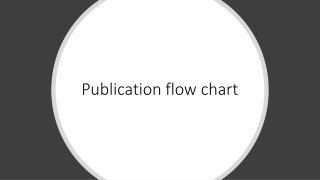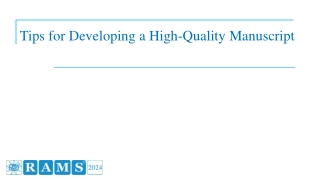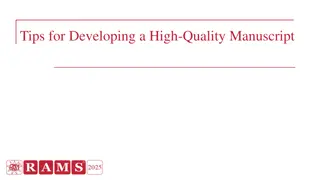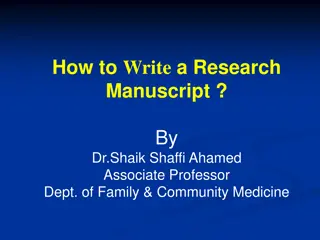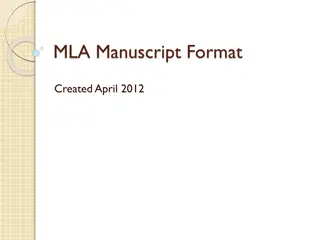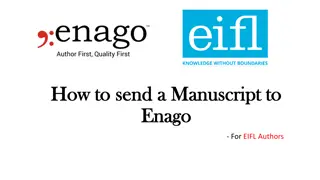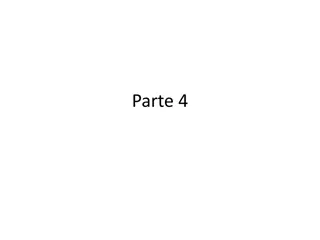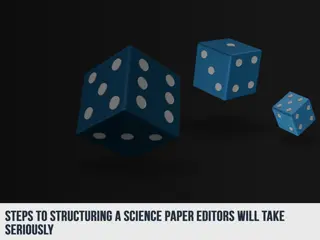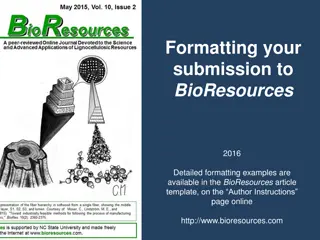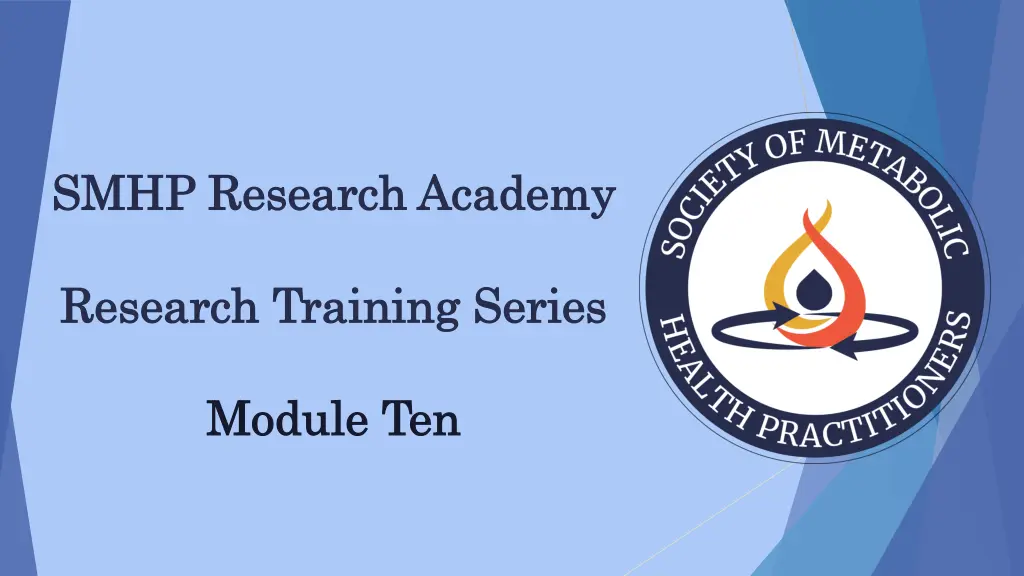
Writing a Research Manuscript: Practical Tips
"Learn essential steps in preparing a research manuscript, from formulating a title to writing the conclusion. Explore strategies for literature source searching, methods section details, and using annotated bibliographies effectively."
Download Presentation

Please find below an Image/Link to download the presentation.
The content on the website is provided AS IS for your information and personal use only. It may not be sold, licensed, or shared on other websites without obtaining consent from the author. If you encounter any issues during the download, it is possible that the publisher has removed the file from their server.
You are allowed to download the files provided on this website for personal or commercial use, subject to the condition that they are used lawfully. All files are the property of their respective owners.
The content on the website is provided AS IS for your information and personal use only. It may not be sold, licensed, or shared on other websites without obtaining consent from the author.
E N D
Presentation Transcript
SMHP Research Academy SMHP Research Academy Research Training Series Research Training Series Module Ten Module Ten
The Society of Metabolic Health Practitioners The Society of Metabolic Health Practitioners Research Training Series Research Training Series Module Ten Module Ten Preparing the Manuscript Preparing the Manuscript Presented By: Dr. Melanie M. Tidman DHSc, MA, OTR/L, MHP 2
Research Training Video Modules Research Training Video Modules Module One Module One Preparing a Clinical Question for Investigation: What is a PICO(T) Preparing a Clinical Question for Investigation: What is a PICO(T) Module Two Module Two Reference Software and Reference Database Management Reference Software and Reference Database Management Module Three Module Three Study Design and Definition of Variables Study Design and Definition of Variables Module Four Module Four The Role of the IRB and Types of Review The Role of the IRB and Types of Review Module Five Module Five Evaluating the Quality of Research Articles Evaluating the Quality of Research Articles Module Six Module Six The Application of the PDSA Project Model The Application of the PDSA Project Model Module Seven Module Seven Types of Research Articles Types of Research Articles Module Eight Module Eight A Brief Review of R, SPSS and Python for Data Analysis A Brief Review of R, SPSS and Python for Data Analysis Module Nine Module Nine The Search for a Journal and Navigating the Author Guidelines The Search for a Journal and Navigating the Author Guidelines Module Ten Module Ten Preparing the Manuscript Preparing the Manuscript 3
Objectives Objectives Discuss how to formulate a Title for your article. Discuss how to formulate a Title for your article. Discuss how to write the Article Abstract and Introduction. Discuss how to write the Article Abstract and Introduction. Define potential Literature Source Search Strategies. Define potential Literature Source Search Strategies. Discuss what is included in the Methods section of the manuscript. Discuss what is included in the Methods section of the manuscript. Discuss how to write the Discussion Section of the manuscript. Discuss how to write the Discussion Section of the manuscript. Discuss how to write the Conclusion. Discuss how to write the Conclusion. Explore how to write and use an Annotated Bibliography to Explore how to write and use an Annotated Bibliography to summarize your supporting articles for future use summarize your supporting articles for future use 4
Thinking About the Title Thinking About the Title Titles: Provide clarity and focus of the article content Increase in discoverability (when well chosen). Attract the intended audience. Establish the relevance and importance of the topic or investigation. Help the reader form an impression of the article.
Titles Should Titles Should Relate to the contents of the article. Stimulate interest. Reflect the tone of the article. Contain important keywords used to locate the article during a keyword search (enago.com/academy, 2023).
Writing the Abstract Writing the Abstract Journals specify the elements and format for an Abstract for their Journal. Example: Strict word limits such as120-250 words. Common Parts of Abstracts: Introduction or Aim Purpose (some do not have this) Methods Results Conclusion Should also contain Keywords
Keywords Keywords Represent Key Concepts Are Searchable Should be descriptive. Reflect a collective understanding of the topic (enago.com/academy, 2023).
Literature Review Literature Review - - Search Strategies Search Strategies Databases to search can include: Pubmed.gov CINAHL Google Scholar Determine Keywords to use and the search filters. Select language and years, and narrow the topic by using Boolean delimiters such as and or not . Determine your inclusion and exclusion criteria for the articles you need. What parameters will you include, and which ones will you exclude Determine how you will grade the quality of the articles you find. What scale will you use (OEBM Scale, The CRAAP Scale, the PedRo Scale, etc.)
Writing the Methods Section Writing the Methods Section Clear and precise description of the experiment. Describes the materials used in the study Explains how the materials were prepared or administered Describes how the research variables were addressed. The rationale for selected procedures Describes the research protocol Justifies the experimental design. Defines any instruments that were used. Describes what was done to answer the research question. Defines the data that was collected Explains how measurements were made and what calculations were performed. Explains how the results were analyzed States which statistical tests were done to analyze the data (Kallet, 2004, pg. 1).
The Results Section The Results Section Hypotheses or Overall Purpose of the Experiment. A picture of the experimental design. Data including text and tables, figures, etc. Summary of the data: highlighting the most important points.
Writing the Discussion Writing the Discussion Describe the study s main findings. Discuss the significance or implication of the findings. Synthesize how the findings are supported by other research: Relate the findings to the wider research context (Kallestinova, 2011).
Writing the Conclusion Writing the Conclusion What is the article s take-home message ? Includes a general statement relating the results to the original research question. Add statements about the scientific implications of your findings. Practical application or advice regarding your findings. Future directions for your topic or research investigation.
Now its time to write the Introduction! Now it s time to write the Introduction! Writing the Introduction last provides more information on exactly what you ended up doing in the study rather than trying to predict the outcomes by writing the introduction first. The Introduction: Reviews the overall intent of your article, the topic, the main idea, and the purpose. Explains any gaps in the existing research that are addressed in your study article. Describes your clinical question under investigation States the value of your research in relationship to current trends or findings.
What about References? What about References? An excellent resource for elements to consider when selecting references or searching for references to support your article: Best Practice for Literature Searches https://ifis.libguides.com/literature_search_best_practice Select supporting articles based on your evaluation of the quality of the article or study using one of the scales we discussed in an earlier video (OEBM, CRAAP, PeDro, GRADE, etc.). When locating research articles, summarize their content in an Annotated Bibliography for later use.
What is an Annotated Bibliography? What is an Annotated Bibliography? Purpose: to summarize your selected sources for later use. Format: List all the sources you found and write a short paragraph underneath each source reference, including: Who did the study? (1 sentence) What was the target population or problem? (1 sentence Describe the Methods (2-3 sentences) Describe the Results (2-3 sentences) Briefly describe the conclusions or recommendations (2-3 Sentences) Briefly describe how the results support your topic or intended research article (1-2 sentences)
Summary Summary Discussed how to develop a title for your article, the Discussed how to develop a title for your article, the elements of the abstract, what to include in the elements of the abstract, what to include in the Methods section, what makes up the Results section, Methods section, what makes up the Results section, the elements of a Discussion section, the basics of the the elements of a Discussion section, the basics of the Conclusion section, and when to write and what to Conclusion section, and when to write and what to include in an Introduction. include in an Introduction. There are several resources to help conduct a There are several resources to help conduct a literature search for relevant references. literature search for relevant references. An Annotated Bibliography is an important tool to An Annotated Bibliography is an important tool to use to summarize your supporting articles for later use to summarize your supporting articles for later 17 use. use.
References References Enago.com/academy.(2023, December 26). 6 Important Tips on Writing a Research Paper Title. https://www.enago.com/academy/write-irresistible-research-paper-title/ Kallestinova ED. How to write your first research paper. Yale J Biol Med. 2011 Sep;84(3):181-90. PMID: 21966034; PMCID: PMC3178846. Kallet RH. How to write the methods section of a research paper. Respir Care. 2004 Oct;49(10):1229-32. PMID: 15447808. 18
Acknowledgements Acknowledgements Sincere Thanks to the Society for Metabolic Health Practitioners for their support of this Research Training Series A/V Editing & Tech Support: Bryson Tidman PowerPoint/Graphic Design: Kathryn Tidman 19
SMHP Research Academy SMHP Research Academy Research Training Series Research Training Series Module Ten Module Ten

